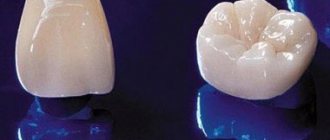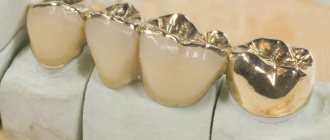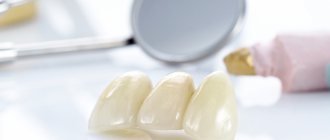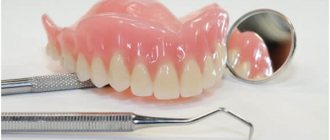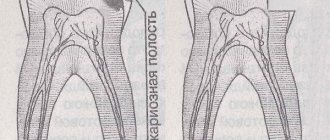What is a stamped metal crown?
Externally, the thin-walled structure resembles the shape of an incisor or molar
A stamped metal crown is an orthopedic prosthesis used in the dental industry to restore dentition.
Externally, the thin-walled structure resembles the shape of an incisor or molar.
This type of prosthetics is used when the root is preserved, and the indication is to partially restore the functionality of the tooth and prevent its further destruction.
The technology for making a prosthesis is the simplest: a shape is tapped from a blank-sleeve that is as close as possible to the impression made on the patient’s jaw.
The thickness of the crown wall depends on the metal used in the manufacturing process of the product. The average value is 0.2-0.3 mm, which determines the parameters for grinding the tooth.
"Advantages and disadvantages"
pros
- The first (and often the decisive) plus is accessibility. The cost can only be compared with plastic products. The average cost of manufacturing and installing one crown without coating (a metal prosthesis without cladding) is about 2,000 rubles in Moscow. With spraying - more than 2200. With different types of linings that hide the metal (linings can be plastic or ceramic) - from 2600 to 5,000.
- The thickness of the walls does not exceed 0.3 mm, which means that, taking into account the additional layer of cement, no more than 0.4 mm is removed from the tooth. That is, depulpation is not performed.
- Speed of production and ease of installation.
- Over the century of use of the method, there are literally isolated cases of rejection of installed crowns as a result of incompatibility of tissues with metals.
Minuses
- Unaesthetic - metal in the mouth, even if it is gold, does not correspond to modern concepts of beauty.
- Insufficient strength of the walls, due to which it quickly grinds down and wears out, allowing infection to penetrate inside.
- Galvanosis is possible - the occurrence of a weak electric current as a result of the impact of acids contained in food and saliva on the metal of the crown.
- The functions of the teeth are not fully restored, and this affects the degree of grinding of food when eating it.
- In cases of “sinks” in the cement layer, aggressive media from food will penetrate to the pulp.
- Anatomical features are not taken into account, which results in incomplete adhesion of the surfaces of opposing teeth.
Clinical and laboratory stages of manufacturing
The process of making crowns requires adherence to certain principles to ensure high-quality installation and minimal likelihood of complications:
- Trying on a finished crown
The orthopedic structure must at least partially perform the function of a tooth.
- There should not be large gaps when the crown touches the neck of the tooth. A small gap is filled with cement, but during wear it gradually collapses. A large gap will cause a number of problems, but a small space is considered normal.
- The prosthesis is fixed in such a way that the metal surface does not sink into the gum groove by more than 0.3 mm. Exceeding this indicator causes the development of marginal periodontal disease.
- When installing a metal structure, it is necessary to maintain the interalveolar interval in relation to the adjacent tooth. Otherwise, injury to a healthy unit or soft tissue may occur.
- The shape of the prosthesis should be close to the anatomical one so that the appearance of a number of teeth is not disturbed and there is no discomfort when wearing the product.
The production of an orthopedic structure includes clinical and laboratory work.
The clinical stages are carried out by an orthopedist in the following sequence:
- The specialist grinds the tooth and creates a stump.
- The choice of color and type of material is made together with the patient.
- Taking impressions from the jaw where the prosthesis is planned to be installed.
- Transferring data to the laboratory technician, where the prosthesis is manufactured.
- Fitting and correction of orthopedic construction.
- Fixing the product with cement mortar.
Laboratory work is carried out by a dental technician.
The stamping technology is as follows:
- Modeling a prosthesis using an impression.
- Obtaining a plaster model.
- To identify the correct ratio of units in the dentition, the model is fixed in the occluder, giving it the position of central occlusion.
- The model is covered with wax and a crown is modeled.
- Making a stamp from a gypsum composition.
- Selection of a suitable sleeve (size, color).
- Stamping of light alloy crowns.
- Transfer the product to the orthopedist for fitting.
- If necessary, perform correction, as well as final grinding and polishing.
Modeling a tooth from wax
Before proceeding directly to the modeling, the technician outlines the clinical equator on the model. The crown is modeled 1 - 1.5 mm short of this equator. This is important for the future tight fit of the crown to the neck of the tooth.
The technician then applies liquid wax to the stump in an even layer, restoring the crown of the tooth. While the wax has not cooled, you need to close the models to get an imprint of the antagonist tooth, this makes it easier to model the chewing surface.
Once the wax has cooled, the technician finalizes the anatomy of the tooth crown. It is important that the crown modeled by the technician is 0.3 mm smaller than the one being restored, i.e. by the thickness of the metal layer. In the future, this gap will be filled with a crown.
a - outlining the line of the neck of the tooth with a pencil. b - border of wax application (dotted line) c - beginning of modeling the chewing surface
Kinds
There are several types of metal structures:
- Dentures are installed in the presence of a destroyed tooth fragment, when it is not possible to install a filling or inlay
Stamped - made on the basis of caps (sleeves) with subsequent giving the workpiece the anatomical shape of the patient’s tooth;
- Cast - the manufacturing process includes casting molten metal into a prepared mold, this makes it possible to obtain precise parameters of the prosthesis and a high-strength product;
- Brazed - the manufacturing technology resembles a stamped one, but the sleeve is first cut into 2-3 parts, after tapping it is joined together by soldering (this method is used in cases where it is not possible to give an anatomical shape to the whole sleeve).
Indications and contraindications for the use of stamped crowns
Stamped crowns resemble caps. They have thin walls, which eliminates the need for preparation. The denture is placed on the tooth.
Stamped crowns are used in the following cases:
- if there is a defect in the crown of the tooth that needs to be restored;
- in order to protect a healthy tooth, before putting on a clasp denture;
- protect the supporting teeth on which the bridge will be installed;
- for milk crops that have undergone destruction.
Contraindications for the use of these types of crowns are: severe abrasion or complete destruction of the tooth, bruxism.
Installation of stamped metal crowns
Fixation of crowns is carried out only after treatment of identified dental diseases. The prosthetic process involves tooth preparation, but the layer of bone tissue removed is minimal compared to other methods of restoring the dentition.
Preparatory work is carried out in the following sequence:
- Removing the top layer of enamel (0.3 mm). The work is performed with a special diamond disc.
- After preparation, the orthopedist checks the gaps between the causative and contacting teeth. The interval should correspond to the thickness of the crown. Control is carried out using a wax sheet.
- The next step is to prepare all contact surfaces (adjustment to the thickness of the crown).
- The process is completed by preparing the oral and vestibular parts of the tooth in order to give the stump a cylindrical shape. The diameters of the stump and neck of the tooth must be the same.
Installation of a crown made of stamped metal is carried out in the following order:
- examination by a doctor of the oral cavity to ensure the absence of inflammatory processes;
- quality control of preparatory work;
- fixing the crown to the stump by applying cement to the joint.
Upon completion of prosthetics, the doctor gives recommendations to the patient on caring for the oral cavity and, in particular, the crown.
Stages of crown installation
Selection of a blank sleeve
Standard steel sleeves are used for stamping. They are produced by the manufacturer in various diameters. All that remains is to choose the appropriate technique. If suddenly a suitable sleeve is not found, you can reduce the sleeve to a larger diameter.
We suggest you familiarize yourself with hypertrophic gingivitis treatment at home
To reduce shell casings, two types of devices are used: the Sharp apparatus and the Samson apparatus. The mechanism of operation of these devices is as follows: There is a matrix with holes of a given diameter and metal pins (Punches). The gap between them is 0.3 mm, just the thickness of the metal. When the handle is twisted, the pin lowers and enters the hole, and the sleeve is pulled out along the diameter of the specified hole. A correctly selected sleeve is difficult to fit onto the die.
During machining, the liner loses its plasticity. Therefore, it needs to be periodically calcined (annealed); without this, the sleeve is difficult to process.
Before stamping, the sleeve is subjected to free forging. In this case, the sleeve is given the orienting shape of the future tooth using a hammer on the anvil. The sleeve is annealed.
Preliminary stamping (Carried out on a special lead plate. Before stamping, a small recess is made on it, using the first stamp, for the occlusal surface of the tooth. The stamp is hammered into the lead plate with a hammer): the sleeve is put on the first stamp and hammered into this stamp in the indicated recess, so that the contours of the chewing surface are imprinted on the sleeve.
Advantages and disadvantages
When choosing the type of crown, it is necessary to compare the existing positive qualities, properties of the material and its disadvantages.
This will relieve discomfort and disappointment in the process of wearing an orthopedic design:
| Characteristics of a stamped metal crown | |
| pros | Minuses |
| Simple technology for making a crown. | Over time, the cement on which the structure sits deteriorates. This leads to the formation of gaps between the dentin and the prosthesis. |
| Possibility of using the structure without preliminary depulping. | The layer of stamped metal is insignificant, so while the crown is worn, its surfaces wear out. |
| The duration of the treatment process does not take much time. | This type of prosthetics does not restore the functionality of the tooth due to the inability to recreate the anatomical shape of a molar or incisor. |
| Low installation requirements, which allows the use of a stamped design even in cases where another type of prosthetics is contraindicated for a number of reasons. | Dentures made of stamped metal do not provide a tight fit to soft tissues, which provokes the penetration of food particles under the structure, where a favorable environment for caries and other diseases develops. |
| During the process of prosthetics, dental tissue is ground, but a minimal layer is removed (0.3 mm). | The aesthetic side of metal products leaves much to be desired. Such a jaw is unlikely to decorate a smile. |
| The use of a stamped metal product is the most affordable type of prosthetics. | |
There are plenty of pros and cons of a stamped prosthesis, but during the analysis it becomes clear that this type, due to its accessibility and simplicity of manufacturing technology, has the right to exist.
What materials are they made from?
The standard base for making crowns is metal, which is subsequently coated or not coated. Inert metals such as silver and gold are used as sputtering materials. In Soviet times, patients preferred to install stamped prostheses made without the use of spraying.
Such products had low cost, increased strength and ease of installation. The consequences of installing metal structures were an unsatisfactory aesthetic appearance, as well as the occurrence of a condition called galvanism. With the development of progress in dental and orthopedic practice, dental crowns began to be made from a plastic base, as well as ceramics. The appearance of such products is as close as possible to natural human teeth.
Such crowns are created from special steel or gold, but the latter option is rarely used today, since the material is quite expensive. In general, the stamping method is outdated, so it is currently used only in rare cases.
So, to create such products one of the following types of steel can be used:
- stainless steel – characterized by increased malleability and a sufficient degree of ductility,
- alloy 1Х18Н9Т – a budget option, characterized by relative lightness.
To create crowns, two types of materials are used.
In this case, steel structures can be coated or without it. In the latter case, the product turns out to be shiny and silver in color. Titanium nitride is usually used as a coating material, which gives the crown a golden color. If we talk about gold structures, then 900 ductile gold with additional 750 karat solder is used to create them.
The structures are created by dental technicians in the laboratory. To begin with, the specialist discusses with the patient the preferred material and color of the future product. Before taking an impression, the doctor eliminates the existing pathological phenomena on the teeth and in the oral cavity as a whole. The impression is made using alginate - this option is considered more gentle compared to plaster. 2 impressions are taken from both jaws, after which a plaster model is cast, which is then transferred to the dental laboratory.
The creation of the structure itself involves the following laboratory manufacturing stages:
- assessment of the central relationship in the presence of malocclusions,
- Plastering the model into an occluder to reproduce vertical movements of the jaws, simulating the opening and closing of the mouth,
- creating a wax model from which a plaster stamp is then cut,
- preparation of an alloy stamp,
- selection of a blank sleeve, its installation on the second die,
- stamping of the finished product and its fitting in order to assess the tightness of the fit and identify possible defects.
The photo shows the process of making crowns
If no problems are found, the product is ground and polished, and sprayed if necessary. The finished crown is fixed using a special cement composition.
Price
Prices for stamped dentures vary depending on the regional location of the clinic and the presence/absence of a sprayed layer
A wide selection of modern materials is gradually replacing the installation of stamped crowns from the list of services of some clinics.
But the presence of an interested segment of consumers still hinders the final refusal to use this material in prosthetics.
Prices for stamped dentures differ depending on the regional location of the clinic and the presence/absence of a sprayed layer.
The cost of a regular crown is 1,500 rubles. You will have to pay a little more for a product with spraying (1,700 rubles). In the case of making a crown with plastic lining, the price will increase to 2000 rubles.
Materials
Stamped crowns are made from 900 gold or special stainless steel (grade 1x18N9T), which is easy to melt and forge. If the factory stamped sleeve is made of gold, then, due to the softness of this variety, the cutting edge is soldered from a metal of a different standard - harder 750.
But usually gold crowns are no longer placed. And yellow metal crowns, manufactured in modern dental prosthetic workshops, are made by sputtering titanium nitride onto steel blanks, imitating 900 gold.
In addition to steel and gold, blanks made of platinum, an alloy of cobalt and chromium, silver-palladium and titanium can be used.
Features of care
Special care for crowns made from stamped metal is not required. The main measures include regular hygiene procedures and thorough cleaning of the oral cavity after eating food.
The list of recommended products includes:
- paste and brush with medium-hard bristles;
- rinse balm;
- dental floss.
After smoking cigarettes or drinking coffee, you need to rinse your mouth with a special liquid; in extreme cases, you can get by with water.
Every six months you need to visit the dental clinic to monitor the integrity of the prosthesis and for thorough cleaning of the oral cavity, which can only be provided by professional cleaning.
Such measures will help prevent the formation of plaque and the growth of stones. Also, based on a number of signs, a specialist can promptly identify the problem and prescribe treatment.
In what cases are indications established?
Stamped crowns are indicated for installation when the visible part of the tooth is destroyed and it is impossible to restore its shape with a filling or inlay. Stamped structures are also used in the presence of the following indications:
- tooth decay due to extensive caries or trauma,
- the need to create a support for the bridge to avoid severe preparation of living teeth,
- to create supports when installing a clasp prosthesis,
- if there is no financial opportunity to install a more modern design,
- sometimes in pediatric orthopedics to restore baby teeth until the bite changes.
Products are used to preserve damaged teeth
Durability
Experts recommend not to wait for complications to arise and to consult a doctor promptly.
The metal alloy stamping is quite thin, so during the operation of the crown it wears out quickly.
The surface, which is often in contact with other teeth, is subject to abrasion.
This explains the short service life, which is indicated by 3-5 years.
Fragility is due to other factors:
- the presence of a gap between the structure and dentin, which provokes the development of caries and other dental problems;
- crown deformation as a result of eating hard foods.
Experts recommend not waiting for complications caused by the above reasons to occur.
Every 2-3 years, crowns simply need to be replaced with new ones, even if the old ones have not yet lost their aesthetic appearance. It is difficult to assess the condition of dentin under the structure, so there is a need for revision.
Stamped crowns: reviews in St. Petersburg
Real reviews and comments from patients about clinics that offer stamped crowns. Which companies can you trust?
More on the topic “Stamped crowns”:
General Prices Reviews
Articles On the map
Add a review
Grigorieva Olga Borisovna
For many years I have been treating my teeth at the Danube clinic with Natalya Mikhailovna Moskvina. This is a highly professional doctor, kind and sensitive. My psyche was already traumatized by Soviet dentistry, when diseased teeth were drilled without anesthesia, and root canal filling was a particularly sophisticated torture. Natalya Mikhailovna cured me of my fear of dental treatment. It’s not scary to go to her because she knows how to properly relieve pain. She treats patients with kindness, this is how doctors should be! Besides me, my husband and children are treated by her if necessary. May God grant her health and strength for many years to come! I also want to thank prosthetist Dmitry Yuryevich Dunaev. He put crowns on me, and did prosthetics for my retired mother. Fast, high quality, professional. An excellent prosthetist and a witty, friendly person. Heartfelt thanks to Natalya Mikhailovna and Dmitry Yuryevich, they can save the most problematic teeth. I recommend the Danube clinic on Tambasova Street to everyone.
Review of the Danube clinic, Krasnoselsky district, 07/03/2019 at 20:29
Answer from the Danube Clinic:
Response from the portal administration:
Vera Sidorova
For several years I have been turning to the ODIS clinic for help at 35 Komendantsky Prospekt, building 1, and I always have only a positive impression. For the last two years, my problems have been solved by a very good doctor, Mikhail Alexandrovich FAUR. Always attentive, friendly and, most importantly, highly professional approach, saves teeth that in another clinic would have been removed long ago. I am 74 years old and problems arise due to the condition of my bone tissue, osteoporosis. Many thanks to Dr. FAUR M.A. he just saves me. The receptionist on duty is always kind and the prices are quite reasonable. I am very grateful and recommend it to everyone.
Review of the Odis clinic, Primorsky district, 10.10.2018 at 10:44
Answer from the Odis clinic:
Response from the portal administration:
Eltukhov Makar
Came here for prosthetics. Of course, I paid attention first of all to the prices and conditions - the cost is real, the office is European-quality renovation, the equipment is imported, the doctor and nurse are smiling, they do not make noise or are nervous. And people said that they were doing well. In the end, I decided on 5 teeth (upper left side). I liked the result - my teeth click like new. It took me a couple of weeks to get used to it, but now I’ve become familiar with them.
Review of the clinic Best Clinic, Admiralteysky district, 06/09/2018 at 15:03
Answer from Best Clinic:
Response from the portal administration:
Valery
I went to the clinic on Tverskaya, I did not expect such responsibility, accuracy, attentiveness and respectful attitude of the doctors. One tooth was repaired and the other was “covered” with a crown. Everything is done with high quality. I express my gratitude to Olga Borisovna Trunkova and Svetlana Olegovna Ivanova.
Review of clinic No. 18, Kolpino district, 06/08/2018 at 19:22
Answer from clinic No. 18:
Response from the portal administration:
Tolstova Rimma
I received prosthetics for a chipped tooth from Igor Vladimirovich Kukurichkin. Exceptional job! The crown fit like a glove, no inconvenience. He explained the actions along the way, was attentive, and careful in everything. I witnessed his conversation with an elderly patient - he politely and patiently explained the same thing to her for SEVERAL MINUTES... Such doctors need to “treat hearts”, not teeth!
Review of the Health clinic, Nevsky district, 06/22/2014 at 23:41
Answer from the Health Clinic:
Response from the portal administration:
Igor Danchenko
I installed 3 crowns, on credit, in Ozerki. Satisfied.
Review of the clinic St. Moritz, Vyborg district, 05/14/2014 at 14:43
Answer from the St. Clinic Moritz:
Response from the portal administration:
Margarita Kornyukhina
Good afternoon I treated my “hollow” with Bulat Iskhakov, i.e. put a crown on a tooth. An amazing doctor, a true professional in his field: fast, high quality, not expensive. It’s a long way from home, so I was constantly late, but they forgave me everything, and I was at the dentist every week on Monday, as per schedule, without any fear I made myself comfortable on the chair in front of the terrifying equipment. So everything is fine, I’m happy with everything. Great dentistry!
Review of the clinic My Dental, Nevsky district, 10.20.2013 at 14:25
Answer from My Dental Clinic:
Response from the portal administration:
Andrey Moshkov
It so happened that now, in the middle of summer, my front crown broke. I am an actor, and for me this trouble was a real disaster, which was complicated by the fact that the clinic where I had previously solved similar problems was closed until the fall!!! It was necessary to do something urgently... “On the advice of friends,” I turned to the Polident+ clinic on Karavaevskaya Street. Imagine my unexpected joy when they immediately made an appointment for me and in 2 days (!!!) my dazzling (just kidding) smile was restored. But that’s not even the main thing! I was delighted and filled with sincere respect by the professionalism of the doctor to whom I went for treatment - doctor Gurkin (unfortunately, I don’t know his name). Unfortunately, I already have a lot of forced experience in contacts with prosthetic dentists, and I can compare. So, doctor Gurkin is just a star! I don’t want to be ungrateful to the doctors with whom I have been treated so far - they are nice and kind people, they have helped me a lot, and besides, it’s cheaper there(!)... but now I want to be treated only here, at Polident+. I can’t help but feel grateful to doctor Gurkin, and I would really like to convey it to the management of Polident+. I have no doubt that they know well what a great specialist creates an excellent reputation for them, but I really want to express my own gratitude - I consider it my duty and do it with great pleasure. Thank you, doctor Gurkin! I can’t help but mention the wonderful intonations and natural friendliness of the girls working at the reception. Of course, we expect good service in a clinic of this level, but how different is it from the usual service that we encounter in our usual, disgusting Russian everyday life.
Review of the Polident+ clinic, Nevsky district, 08/01/2013 at 16:56
Answer from the Polident+ clinic:
Response from the portal administration:
Gurinova Yulia
Broke my front tooth! and turned to Stoma Lux, accidentally ended up with Tatyana Valerievna, she consulted, put a temporary crown, selected the color, was very careful and attentive, spent so much time fiddling with my tooth. She’s a very nice girl. I’ll come to her for more dental treatment.) THANK YOU SO MUCH! !!
Review of the Stoma-Lux clinic, Moskovsky district, 04/19/2013 at 09:11
Answer from the Stoma-Lux clinic:
Response from the portal administration:
Ravilya Sayetova
I only went to Gera Dentistry once, but so far I can’t say anything bad about either the doctors or the patient service. The wall of my five at the top broke off, and they explained to me why it was better to put a crown than to restore a tooth (taking into account my situation, of course). I am a doctor myself, and I realized that they were offering me a better option, albeit more expensive. In two days we carried out the treatment, made an impression, installed a temporary crown, and a week later a permanent one. The color was chosen perfectly, no pain, discomfort or discomfort. Personally, I'm very pleased. And the prices are really normal - do we have cheap services?
Review of the Velum clinic, Vasileostrovsky district, 02/14/2013 at 22:31
Response from Velum Clinic:
Response from the portal administration:
Svetlana
I am receiving treatment at Blagodatnaya. Disgusting staff. I came in with caries. They charged 3 thousand for the filling and redid it 3 times until there was a piece of tooth left. Now the next one is crumbling and crumbling. I thought my teeth were crumbling at age -45. I went elsewhere for a consultation. They said that the problem is with the doctors, and not with calcium. All the teeth need to be redone... In general, it’s a disaster
Review of clinic No. 12, Moskovsky district, 10/15/2012 at 19:53
Answer from clinic No. 12:
Response from the portal administration:
Barykina Isolda Vladimirovna
I am surprised by the negative ratings of the Roadster clinic. In my opinion, all these reviews are dubious. Personally, I insert teeth and crowns there. The doctor, Nikolai Semenovich, is a high-class specialist. The work is simply jewelry. The attitude is attentive and sensitive. There is no pursuit of the price of the material that is observed in other clinics, where they will not offer anything other than metal-ceramics, yes and they don’t want to talk. I thank the Supreme One that I miraculously ended up in this clinic and here they treated me like a human being, despite the fact that I made an order not from expensive material. I didn’t feel like Cinderella like in the clinics at Enlightenment. If you’re dissatisfied, go there,
Review of the Roadster clinic, Vyborg district, 12/27/2011 at 21:14
Response from the Roadster Clinic:
Response from the portal administration:
Zhanna Zosimova
Anatoly, when 2/3 of a tooth is destroyed, the optimal solution is prosthetics using a crown and a stump inlay. The doctor was also ready to install a filling or a composite inlay for you, but these types of work cannot be guaranteed in your case. How can one not talk about “guaranteed loss of a tooth in about ten years” after its prosthetics? And, of course, it is impossible to predict what will happen in ten years to any healthy tooth. We wish you successful treatment and as few reasons as possible for visiting dentists)))
Review of the Medi clinic, Central district, 12/15/2011 at 09:19
Answer from the Medi Clinic:
Response from the portal administration:
hope
I am happy with my Nobel implants, beautiful crowns. Probably, if you want to find fault, you will find something to do... Friendly doctor Sergei Dmitrievich, wonderful hands. He will answer any question warmly and with humor. Now my mother is getting prosthetics and also walks without whims. The girls at the reception are combative, talkative. What else does a person need for good mood? Don't look for bad things where they don't exist.
Review of the Azbuka Health clinic, Central district, 12/15/2011 at 03:27
Answer from the Azbuka Health clinic:
Nadezhda, thank you for your feedback, have a good mood!
Response from the portal administration:
Anatoly
I was treated at Med on Sovetskaya for just one visit (they put me on medicine) and didn’t go back. There is a blatant imposition of unnecessary and unnecessary things. Initially, together with the prosthetist who was called, they said that this tooth was only for a crown, since the filling would not hold, it would definitely collapse from the load from the opposite tooth. I expressed my categorical disagreement and seemed to persuade (as I thought) them to at least install a filling instead of a crown that is not light-curing, but made by a prosthetist that does not shrink. Due to great doubts about everything that the dentist and prosthetist told me, I went to another clinic in the same price range and found out for myself that there are no contraindications to installing a regular filling for this tooth, since this tooth does not have an opposite one and simply will not have the same loads about which they told me noodles. Conclusion: money bags are being scammed into paying triple or more for absolutely unnecessary and sometimes harmful things. After all, you need to understand that if you succumb to placing a crown now (during placement, the tooth is ground down and it is no longer good for anything, the next stage is implantation), remove the roots under the pretext of a very thin wall, which increases the cost of treatment many times over, but which they often don’t know leads to a guaranteed loss a tooth after about ten years due to its rejection by the body, because without nerves it is dead, and it often turns out that the thin wall is actually thin only for this doctor, that in this way he simply increases the cost of treatment and ensures work for himself or his colleagues in ten years. About imposing the removal of nerves for a reason, but also having experience of treatment in Med, but already at Ligovsky then he completed his treatment; their teeth remained with nerves, healthy to this day (more than eight years have passed), but you should have seen the doctor’s dissatisfaction because they broke off his fat jackpot Advice: 1) don’t be lazy to look at the tooth photo yourself before you agree to remove the nerves, because these are your teeth and there are only 32 of them. 2) the quality of the treatment is good, but you need to be careful about imposing unnecessary services because they can harm you.
Review of the Medi clinic, Central district, 12/13/2011 at 09:35
Answer from the Medi Clinic:
Response from the portal administration:
Maria
They ruined my tooth, they ended up getting a crown, I’ll never go there again
Review of the Tonklav clinic, Nevsky district, 12/08/2011 at 12:22
Answer from the Tonklav clinic:
Response from the portal administration:
Anastasia
I WILL NOT SIT DOCTOR DENTAL AGAIN! And I don’t recommend it to anyone, if you want to stay healthy and have your nerves intact, not to mention improve your health, that’s why they go to the clinic in the first place. I came there with a chipped tooth without any complaints of pain. After the examination, the doctor, Ekaterina Sergeevna, informed that the cost of treatment would be 1,200 rubles. filling + approximately 6800 rub. crown. 1) The doctor attempted to start dental treatment without taking a preliminary photograph. 2) The anesthetic injection did not work, so for 3 visits she WORKED ON THE ROOT CANAL “LIVE”. The pain is terrible! And it’s not surprising, because poking the nerves with a needle without anesthesia is nothing worse than torture. As a result, I was unable to clean the root canals in 3 visits and each time I was sent home with disturbed nerves and with medicine in my tooth. Ekaterina Sergeevna did not think of changing the painkiller to another one. 3) In addition, she BROKE AND LEFT THE INSTRUMENT IN THE ROOT CANAL. What she didn’t inform me about, and what I learned about only from pictures from other dentists. 4) FROM HER MEDICATIONS, THE GUM HAS DEATHED AROUND THE TOOTH and a large “pocket” has formed 5) As a result, the tooth, which was not hurting, hurt terribly for a month. 6) The tooth remained untreated. And the results of Ekaterina Sergeevna’s unskilled work had to be corrected in other clinics for 12,000 rubles instead of 1,200 rubles. and this is without a crown (only work on root canals) If you don’t want to get health problems by going to the clinic, it’s better NOT TO GO TO DOCTOR DENTAL!!!!! Go where your health will improve, not worsen!!!!
Review of the clinic Doctor Dental, Moskovsky district, 12/06/2011 at 11:16
Answer from the clinic Doctor Dental:
Response from the portal administration:
Elena
Before the vacation, I had to urgently get dentures, visited several clinics, ended up at “Veronica” with Aleksey Valerievich Balandin, (orthopedic dentist at the clinic on Sredny, 48/27), promised reasonable terms and prices, but deceived me on both counts. It was necessary to place an implant and two crowns. Started in June, finished in October. The bite has changed, now all my teeth hurt, everything needs to be redone. Throughout the work there is a constant scam for money. I really regret that I ended up with a greedy unprofessional.
Review of the Veronica clinic, Primorsky district, 11.27.2011 at 19:01
Answer from the Veronica Clinic:
Response from the portal administration:
Andrey
“bunny” Ivan Ivanovich...what a creepy Krol!!)) Wonderful. I recommend Liliya Ivanovna Krutova. She expanded my upper gums for subsequent implantation. GREAT! Works great. After this, no more Medi-parapedi...that's enough! Usachev, Konstantin Alekseevich - head of the orthopedics department - removable crowns, etc. - + 100!!! Only after I accidentally ended up with him did I drop everything and begin full treatment. They say everything honestly, the prices are real, the quality is excellent. I took on something that either wasn’t taken on, or other clinics quoted unrealistic prices...
Review of the clinic, Medical Unit No. 157, Moskovsky district, 10.20.2011 at 18:36
Answer from the medical unit clinic No. 157:
Response from the portal administration:
Olga Lisenkova
She was treated at Raiden in 2003-2006. I was very pleased that I found an excellent clinic where they treated me carefully and treated me professionally. Their prices were higher than others back then, but still quite reasonable. I really liked the doctor Tatyana Mikhailovna Yakupova (she later moved to the department at Udelnaya to work). Then she cured all her problems, both caries and pulpitis. I had 2 metal-ceramic crowns made in the same clinic. Doctor Voronovsky V.S. (while I was still there, he either transferred to another office or quit, I don’t know). She lived quietly for several years. Now I feel like I need to go get treatment again. I have had problems with my teeth since childhood. I rushed to Raiden’s website, but unfortunately, due to their exorbitantly increased price tags for treatment, I will look for another clinic. It’s a pity. The price tag on the website is higher than what is shown here.
Review of the Raiden clinic, Central district, 09.24.2011 at 14:34
Response from the Raiden Clinic:
Response from the portal administration:
close
Forward
Installation steps and preparation
At the laboratory stage, the process of manufacturing stamped metal crowns includes a number of such sequential manipulations:
- The model is made of plaster according to a previously taken cast.
- Next, the dentist forms a gum model by layer-by-layer application of special molten wax.
- The penultimate stage is selecting the required sleeve and giving the required shape
- The final stage is the production of a metal crown by stamping it. The finished product is sent to a dentist for subsequent installation.
At the clinical stage, the process of installing dental crowns includes the following steps:
- Preparing a damaged tooth for installation (grinding)
- Selection of the color of the microprosthesis depending on the individual characteristics of the patient’s enamel
- An impression is taken of the damaged tooth on which the stamped metal prosthesis will be installed.
- The finished impression is sent to a dental technician to make a crown.
- The finished crown is tried on the ground tooth, and adjustments are made depending on the nuances that arise.
- After the metal prosthesis meets the requested parameters, it is securely fixed over the ground tooth
As mentioned above, a prerequisite for the correct installation of a stamped metal crown is the preliminary preparation of the tooth on which the product will be installed and its depulpation (nerve removal). The preparation process itself involves selective removal of a thin layer of tooth tissue. This technique includes the following steps:
- Primary tooth treatment is carried out using so-called diamond wheels, which remove no more than 0.5 mm of dental tissue. The thickness of the removed layer directly depends on the presence or absence of spraying, as well as the material from which the prosthesis was made
- At the second stage of preparation, the medical specialist checks the space located between the prosthetic tooth and its antagonist. For this purpose, a wax strip is used, which the patient is asked to bite. The finished wax impression is assessed by the dentist
- At the third (penultimate) stage of preparation, the proximal surfaces of the tooth are processed. To achieve this goal, special discs made of diamond material are used.
- At the final stage, the dentist prepares the palatal and buccal surface, which gives the dental stump a cylindrical shape
There is also a list of nuances that must be taken into account when installing and manufacturing this type of dentures. Such nuances include:
- The installed prosthesis must fully compensate for the functionality of the damaged tooth, as well as restore its chewing function as much as possible.
- The finished crown should fit tightly around the neck of the damaged tooth. If the product is too wide, then over time irritation of soft tissues will form, followed by gum atrophy
- The penetration into the groove should not be carried out to a depth of more than 0.3 mm. If this figure is increased, the patient will develop acute marginal periodontitis
- The stamped metal product must fully replicate the anatomical shape and structure of the damaged tooth. The product must contain equators and all existing tubercles
If the listed conditions were met during the manufacture and installation of the prosthesis, then its operation will be as comfortable as possible, without the risk of complications.
Preparing a tooth for prosthetics
- In order for the crown to sit firmly on the tooth, it must first be ground, removing a thin layer of enamel. Usually the doctor removes about 0.5 mm. It may be necessary to remove a thicker layer. This depends on the material from which the prosthesis will be made. If gold is used, then you will have to grind more, because in this case gold solder will need to be poured onto the inside of the structure. This will significantly increase the service life of the crown.
- Now the doctor needs to check the gap between the tooth being prepared and its antagonist. To do this, the patient bites on a special wax strip, and the doctor checks the resulting imprint.
- Using diamond separating discs and shaped heads, the dentist processes the proximal surfaces.
Before installing a crown, additional preparation is necessary to ensure that the crown sits firmly on the tooth. The required tooth is first wrapped and a thin layer of enamel is removed.
- After this, all that remains is to process the buccal and palatal surfaces and create a stump in the form of a cylinder. The diameter of the stump should be equal to the diameter of the tooth neck. This is the only way the prosthesis can fit well onto the tooth. If you violate the proportions, the structure will not fit tightly.
This is interesting: One-sided clasp dentures for teeth - which ones are better for the upper jaw: types by material and method of fastening
